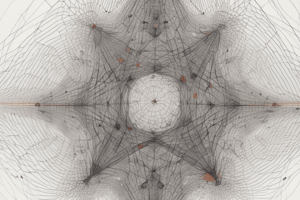Podcast
Questions and Answers
¿Qué es el objeto de estudio en la teoría de grafos?
¿Qué es el objeto de estudio en la teoría de grafos?
- Las conexiones entre objetos (correct)
- Los algoritmos de búsqueda
- Las redes sociales
- Los algoritmos de ordenamiento
¿Cuál es la característica principal de un grafo dirigido?
¿Cuál es la característica principal de un grafo dirigido?
- Tiene un nodo central
- Cada arista tiene una dirección (correct)
- No tiene ciclos
- Tiene conexiones bidireccionales
¿Qué es la conectividad de un grafo?
¿Qué es la conectividad de un grafo?
- La cantidad de nodos en el grafo
- Una medida de la robustez y resiliencia de una red (correct)
- La cantidad de aristas en el grafo
- La cantidad de ciclos en el grafo
¿Cuál es el propósito de los algoritmos de recorrido de grafos?
¿Cuál es el propósito de los algoritmos de recorrido de grafos?
¿Qué es un grafo conectado?
¿Qué es un grafo conectado?
¿Cuál es el objetivo principal del problema de coloreado de grafos?
¿Cuál es el objetivo principal del problema de coloreado de grafos?
¿Qué es un ejemplo de una aplicación de la teoría de grafos en la vida real?
¿Qué es un ejemplo de una aplicación de la teoría de grafos en la vida real?
¿Qué tipo de problema de optimización se enfrenta en sistemas de flujo de red?
¿Qué tipo de problema de optimización se enfrenta en sistemas de flujo de red?
¿Cuál es el propósito de la visualización de grafos?
¿Cuál es el propósito de la visualización de grafos?
¿Qué campo de estudio utiliza la teoría de grafos para analizar la estructura de redes sociales?
¿Qué campo de estudio utiliza la teoría de grafos para analizar la estructura de redes sociales?
Flashcards are hidden until you start studying
Study Notes
Graph Theory
Graph theory is a subfield of mathematics that deals with graphs, which are abstract representations of connections between objects. It is concerned with the properties, relationships, and behavior of graphs, as well as with the algorithms and techniques used to analyze them. Graph theory has applications in various disciplines, including computer science, economics, sociology, biology, and more.
Key Concepts in Graph Theory
Directed and Undirected Graphs
A graph is a set of nodes (also called vertices) connected by edges. A directed graph (or digraph) is a graph in which each edge has a direction, from a source node to a target node. An undirected graph is a graph in which each edge is bidirectional, meaning it connects two nodes in both directions.
Connectedness and Connectivity
A graph is connected if there is a path between any two nodes in the graph. The connectivity of a graph is a measure of how well-connected it is, and it can be used to analyze the robustness and resilience of a network.
Graph Traversal Algorithms
Graph traversal algorithms, such as depth-first search (DFS) and breadth-first search (BFS), are used to explore and analyze the structure of a graph. These algorithms help to find the shortest path, detect cycles in a graph, and determine the connected components of a graph.
Graph Coloring
Graph coloring is the process of assigning colors to the nodes of a graph such that no two adjacent nodes have the same color. This problem has applications in scheduling, map coloring, and other areas where resources need to be allocated without conflicts.
Graph Optimization and Network Flow
Graph theory is also used to model and analyze network flows, such as transportation, communication, and water or electricity distribution systems. Optimization problems in these systems involve finding the shortest path, minimizing the cost, or maximizing the efficiency of the network.
Graph Representation and Visualization
Graphs can be represented in various ways, such as adjacency matrices, adjacency lists, or edge lists. Visualizing graphs using graph layout algorithms and graph drawing software can help to understand the relationships between nodes and edges and to identify important patterns and structures in the graph.
Applications of Graph Theory
Graph theory has many applications in different fields, including:
- Social networks: Analyzing the structure of social networks helps to understand the spread of information, the formation of groups, and the emergence of leaders.
- Computer networks: Graph theory is used to model and optimize the design and performance of computer networks, such as the internet and local area networks.
- Biological systems: Graph theory is used to model and analyze the interactions between different biological entities, such as cells, genes, and proteins.
- Transportation systems: Graph theory is used to model and optimize the flow of goods, people, and information through transportation networks, such as road and railway systems.
- Economic systems: Graph theory is used to model and analyze complex economic systems, such as supply chains, financial markets, and trade networks.
In conclusion, graph theory is a fundamental and versatile mathematical discipline that provides tools and techniques for understanding and analyzing the structure and behavior of networks. Its applications span across various fields, from computer science and social sciences to biology and economics, and its importance continues to grow as complex systems become increasingly prevalent in our society.
Studying That Suits You
Use AI to generate personalized quizzes and flashcards to suit your learning preferences.



